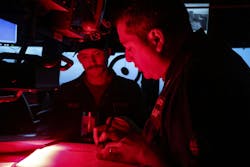Boeing to provide fiber optic Navy shipboard networking for navigation displays and machinery control
WASHINGTON – Military communications experts at the Boeing Co. will continue their support for U.S. Navy high-speed fiber-optic shipboard networking under terms of a $20.3 million order announced last week.
Officials of the U.S. Naval Sea Systems Command in Washington are asking the Boeing Defense, Space & Security segment in Huntington Beach, Calif., to continue support of the shipboard AN/USQ-82(V) family of shipboard networking systems.
The AN/USQ-82(V) family consists of the Data Multiplex System (DMS), the Fiber Optic Data Multiplex System (FODMS), and Gigabit Ethernet Data Multiplex System (GEDMS).
The AN/USQ-82(V) family of shipboard networking equipment transfers inputs and outputs for a surface warship's machinery control systems, damage-control system, steering control system, Aegis combat system, navigation displays, and interior communications alarms and indicators.
Replaces traditional cabling
Boeing designed this shipboard network equipment to replace the mile of point-to-point cabling, signal converters, junction boxes, and switchboards that make up a conventional ship’s cabling, Navy officials say.
As the AN/USQ-82(V) design agent, Boeing will provide advanced and specialized system sustainment technical engineering; cyber security enhancement; configuration management; systems development, qualification, and integration; testing; and technical support to manufacturing and repair vendors.
The AN/USQ-82(V) is being installed on U.S. Navy Burke-class destroyers, as well as in upgrades to flight I/II Burke-class destroyers and to flight IIA Burke-class destroyers.
Surface warships with similar capabilities and data-throughput requirements to the Burke-class destroyer are Japan's Kongo-class guided-missile destroyers; Korea's Sejong the Great-class destroyers; Australia's Hobart-class air-warfare destroyers; and Canada's future Surface Combatant.
The AN/USQ-82(V) is designed to transfer data via a reliable, redundant, mission-critical network backbone aboard Navy surface warships. It is the most recent upgrade to the Navy's Data Multiplex System (DMS) networks, and offers enhanced network communication capabilities by providing an IP-based backbone that supports multimedia services such as video and data.
AN/USQ-82(V) offers manpower reduction and increased crew safety by using video and sensors for monitoring remote or confined shipboard spaces, Boeing officials say.
In September 1989, Boeing delivered the first DMS system to the Navy for installation aboard the USS Arleigh Burke, the namesake for the DDG 51 class destroyer. As the DDG new ship construction continued, the DMS was upgraded to the Fiber Optic Data Multiplex System (FODMS) to support evolving needs.
Substitute for copper
In August 2010, the Navy replaced the copper-based DMS systems installed on the Arleigh Burke and the USS John Paul Jones (DDG 53) with the high-performance fiber-optic AN/USQ-82(V), the latest variant in the DMS family of networks.
The manufacturer of the AN/USQ-82(V) fiber-optic shipboard network is Argon ST in Fairfax, Va., a wholly owned subsidiary of Boeing, which acquired Argon ST in 2010 to expand capabilities in C4ISR, cyber security, and intelligence.
On this order, Boeing will do the work in Huntington Beach, Calif.; Bath, Maine; Pascagoula, Miss.; Annapolis Junction, Md.; and Tukwila, Wash., and should be finished by May 2026. For more information contact Boeing Defense, Space & Security online at www.boeing.com/company/about-bds, Argon ST at www.argonst.com, or Naval Sea Systems Command at www.navsea.navy.mil.
About the Author
John Keller
Editor-in-Chief
John Keller is the Editor-in-Chief, Military & Aerospace Electronics Magazine--provides extensive coverage and analysis of enabling electronics and optoelectronic technologies in military, space and commercial aviation applications. John has been a member of the Military & Aerospace Electronics staff since 1989 and chief editor since 1995.
